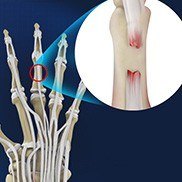Extensor Tendon Injuries

What are Extensor Tendon Injuries?
Tendons are bands of tissue connecting muscles to bones. The extensor tendon is a strong, smooth cord that connects finger bones to muscles in the hand. Extensor tendons are located just under the skin, directly on the bone, on the back of the hand and fingers. They allow you to open your hands and move or straighten your wrist, fingers, and thumb.
Extensor tendon injury is a partial or complete damage to the tendon. This can be caused due to:
- Cut on the back of the fingers
- Jamming of the fingers
- Stubbing of the fingers
- Crush injury on the back of the fingers
- Hand trauma or overuse
- Laceration or broken bone in the fingers
- Nerve compression
Injury to the extensor tendon may result in a tendon tear or tendon rupture, and the condition can greatly affect the grip, fine motor function of the hand, and stability of the wrist. Some of the types of extensor tendon injuries include:
- Mallet finger: Characterized by the drooping of the end-joint of a finger due to a cut or a tear of the extensor tendon at the last joint.
- Boutonniere deformity: Characterized by a bent-down (flexed) position of the middle joint of the finger caused by a cut or tear to the extensor tendon at the middle joint.
What are the Signs or Symptoms of Extensor Tendon Injuries?
The most common symptoms of extensor tendon injury are pain and swelling at the tip of the finger. Other major symptoms include:
- Redness and warmth near the injury
- Stiffness in the finger joint
- Inability to straighten the finger or thumb
- Downward drooping of the finger or the thumb
- Increased discomfort with activity
- Crepitus (crunchy feeling at the affected tendon)
- Finger deformity or loss of function
What If the Condition is Left Untreated?
If left untreated, extensor tendon injuries may result in:
- Permanent damage of the extensor tendon
- Inability to straighten the finger or thumb
- Serious functional impairment
- Permanent deformity or disability
How is the Condition Diagnosed?
In order to diagnose extensor tendon injuries, your doctor may ask questions about your pain and other symptoms and perform a physical examination of the affected hand. The doctor may also order an X-ray to ensure no bones are fractured. In severe cases, ultrasound or MRI may be performed to identify the extent of damage and to get a detailed view of all the bones, muscles, and tendons around the injury.
How are Extensor Tendon Injuries Treated?
Conservative Treatment
Usually, if the injury is mild, the symptoms resolve with adequate rest and icing. However, specific treatment for an extensor tendon injury varies according to the level of its severity.
Nonoperative treatments are the first option and usually include:
- Splinting the affected part to heal in proper alignment
- Anti-inflammatory medications
- Special exercises and hand therapy
Surgical Treatment
Extensor tendon repair surgery may be performed under local, regional or general anesthesia. The ends of the injured tendon are sutured and a pin (as an internal splint) may be placed. Post-operatively, the treated area will be immobilized in a splint to allow the tendon to heal.
In cases of motion loss, surgery can involve freeing the scar tissue followed by hand therapy. For severe injuries involving a major laceration or complete tendon rupture, surgical options such as tendon repair, tendon reconstruction, extensor indicis proprius/extensor pollicis longus (EIP/EPL) tendon transfer, or bony avulsion fixation may be performed.
Extensor tendon repair surgeries are usually safe however as with any surgery there are potential risks including infection, adhesion formation, tendon rupture, repair break, loss of flexion, and a weakened grip.
Related Topics
- Pediatric Forearm Fracture
- Wrist Fracture
- Fractures of the Hand and Fingers
- Wrist Sprain
- Flexor Tendon Injuries
- Mallet Finger
- Finger Sprain
- Thumb Fracture
- Scaphoid Facture
- Finger Dislocation
- Adult Forearm Fractures
- Arthritis of the Hand and Wrist
- Forearm Fractures in Children
- Arthritis of the Thumb
- Ganglion Cyst
- Boutonniere Deformity
- Carpal Tunnel Syndrome
- De Quervain's Tendinosis
- Dupuytren's Contracture
- Trigger Finger
- Congenital Defects of the Hand and Wrist
- Hand Pain
- Hand Infections
- Wrist Injuries
- Wrist Tumors
- Gamekeeper's Thumb
- Hand Tumors
- Extensor Tendon Injuries
- Fingertip Injuries
- Wrist Ligament Tear and Instability
- Metacarpophalangeal Joint Arthritis
- Malunion of a Fracture

